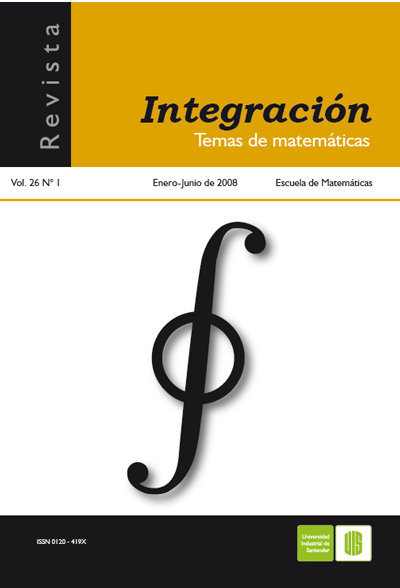Published 2008-02-29
Keywords
- Polymerization,
- Hemoglobin S,
- Sickle Cell, Modeling
How to Cite
Abstract
The molecular aggregate formation mechanisms play a major role in the interpretation of the pathophysiology of Sickle Cell disease and in the selection of the therapeutic strategies to follow.
A mechanism and a mathematical model are proposed. The model postu-lates the existence of defective microtubules formed by deoxy hemoglobin S and oxy hemoglobin S, and explains the dependence of polymerization on hemoglobin concentration, temperature, and partial oxygen pressure. The analysis focuses on the polymerization of hemoglobin S in the absence of crystallization. The action of other kinds of hemoglobin in the molecular aggregate formation process can be explained.
Downloads
References
[2] W.A. Eaton, J. Hofrichther, “Sickle Cell Hemoglobin Polymerization”, Advances in Protein Chemistry. 40 (1990) 63-279.
[3] C.T. Noguchi, A.N. Schechter, “The Intracellular Polymerization of Sickle Hemoglobin and its Relevance to Sickle Cell Disease”, Blood. 58 (1981) 1057-1068.
[4] G.M. Brittenham, A.N. Schechter, C.T. Noguchi, “Hemoglobin S Polymerization: Primary Determinant of the Hemolytic and Clinical Severity of the Sickling Syndromes”, Blood. 65 (1985) 183-189.
[5] J. Dean, A.N. Schechter, “Sickle-cell anemia. Molecular and cellular bases of therapeutic approaches”, N. Engl. J. Med. 299 (1978) 725-763.
[6] R.W. Brieehl, “Gelation of Sickle Cell Hemoglobin. IV. Phase Transition in Hemoglobin S Gels: Separate Measures of Aggregation and Solution-Gel Equilibrium”, J. Mol. Biol. 123 (1978) 521-538.
[7] J. Han, J. Herzfeld, “Interpretation of the Osmotic Behavior of Sickle Cell Hemoglobin Solutions: Different Interactions Among Monomers and Polymers”, Biopolymer. 45 (1998) 299-306.
[8] H. Chang, R.L. Nagel, “Measurement of Sickling by Controlled Temperature Increase”, Blood. 52 (1978) 1189-1195.
[9] R.C. Cheetham, E.R. Huehns, M.A. Rosemeyer, “Participation of Hemoglobins A, F, A2 and C in Polymerization of Hemoglobin S”, J. Mol. Biol. 129 (1979) 45-61.
[10] R.E. Benesch, R. Benesch, R. Edalji, S. Kwong, “Intramolecular Effects in the Polymerization of Hemoglobin S”, Biochem. Biophys. Res. Comm. 81 (1978) 1307-1312.
[11] H.R. Sunshine, J. Hofrichter, W.A. Eaton, “Gelation of Sickle Cell Hemoglobin in Mixtures with Normal Adult and Fetal Hemoglobins”, J. Mol. Biol. 133 (1979) 435-467.
[12] A.N. Schechter, G.P. Rodgers, “Sickle Cell Anemia, basic research in the clinic”, N. Eng. J. Med. 332 (1995) 1372-1374.
[13] H.F. Bunn, “Pathogenesis and Treatment of Sickle Cell Disease”, N. Engl. J. Med. 337 (1997) 762-769.
[14] K. Bailey, J.S. Morris, P. Thomas, G.R. Serjeant, “Fetal hemoglobin and earlymanifestation of homozygous sickle cell disease”, Arch. Disea. Childhood. 67 (1992) 517-520.
[15] T.E. Wellems, R. Josephs, “Crystallization of Deoxyhemoglobin S by Fiber Alignment and Fusion”, J. Mol. Biol. 135(1979) 651-674.
[16] X.Q. Mu, B. Fairchild, “Computer models of a new deoxy-sickle cell hemoglobin fiber based on x-ray diffraction data”, Biophys. J. 61(1992) 1638-1646.
[17] T.H. Maugh, “A New Understanding of Sickle Cell Emerges. X-ray, kinetic studies paint a comprehensive picture of Sickle Cell Disease to the level of atomic interactions”, Science.211 (1981) 265-267.
[18] A.N. Schechter, C.T. Noguchi, “Sickle Hemoglobin Polymer: Structure-Function Correlates”, Chap. 4. In Sickle Cell Disease: Basic Principles and Clinical Practice. Ed. by S.H. Embury, R.P. Hebbel, N. Mohandas, M.H. Steinberg, Raven Press, Ltd, New York, 1994.
[19] A.A. Kaperonis, D.A. Handley, S. Chien, “Fibers, Crystals, and other Forms of HbS Polymers in Deoxygenated Sickle Erythrocytes”, Am. J. Hematol. 21 (1986) 269-275.
[20] G.W. Dykes, R.H. Crespeau, S. J. Edelstein, “Three–dimensional reconstruction of 14-filament fibers of hemoglobin”, J. Mol. Biol. 130 (1979) 451-472.
[21] A. Roufberg, F.A. Ferrone, “A model for the sickle hemoglobin fiber using both mutation sites”, Protein Sci. 9 (2000) 1031-1034.
[22] A. McPherson, “Current approaches to macromolecular crystallization”, Eur. J. Biochem. 189 (1990) 1-23.
[23] G. Agarwal, J.C. Wang, S. Kwong , S.M. Cohen, F.A. Ferrone, R. Josephs, R.W. Briehl, “Sickle hemoglobin Fibers: Mechanisms of Depolymerization”, J. Mol. Biol.322 (2002) 395-412.
[24] P.C. Weber, “Protein Crystallization”, Advan. in Protein Chemistry. 41 (1991) 1-5.
[25] F.A. Ferrone, J. Hofrichter, W.A. Eaton, “Kinetics of sickle hemoglobin polymerization I. Studies using temperature jump and laser photolysis techniques”, J. Mol. Biol.183 (1985) 591-610.
[26] F.A. Ferrone, J. Hofrichter, and W.A. Eaton, “Kinetics of Sickle Hemoglobin Polymerization. II A double nucleation mechanism”, J. Mol. Biol. 183 (1985) 611-631.
[27] M. Ivanova, R. Jasuja, S. Kwong, R.W. Briehl, F.A. Ferrone, “Nonideality and the nucleation of sickle hemoglobin”, Biophys. J. 79 (2000) 1016-1022.
[28] V.B Makhijani., G.R. Coketet, A. Clark, “Dymanics of oxygen unloading from sickle erythrocytes”, Biophys. J. 58 (1990) 1025-1050.
[29] F.A. Ferrone, M. Ivanova, R. Jasuja, “Heterogeneous Nucleation Crowding in Sickle Hemoglobin. An Analytic Approach”, Biophys. J. 82 (2002) 399-406.
[30] M. Ivanova, R. Jasuja, S. Kwong, R.W Briehl, F.A. Ferrone, “Nonideality and the nucleation of Sickle Hemoglobin”, Biophys. J. 79 (2000) 1012- 1022.
[31] C. Cabal, A. Fernández, M. Lores, E. Álvarez, J. Losada, C. Soler, E. Pérez, “Magnetic Relaxation in the Kinetics of the Polymerization of Hemoglobin S. Clinical Diagnosis and Treatment with Vanillin”, Proceedings International Society for MagneticResonance in Medicine, 3 (1998) 1705, Sydney, April 18-24.
